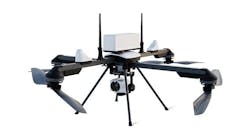New Site Adds Airport Runway as Option for Drone Test Flights at Lone Star Unmanned Aircraft Systems Center
CORPUS CHRISTI, Texas – The Lone Star Unmanned Aircraft Systems Center at Texas A&M University-Corpus Christi now has an airport and runway in its approved flight ranges.
The Federal Aviation Administration recently approved a new range to test and fly unmanned aircraft that includes the Port Mansfield airport.
The center, located in Corpus Christi, is one of only six federally-designated test sites for unmanned aircraft systems (UAS). The sites will provide critical data to the FAA, as the agency develops rules, processes and procedures required to safely operate UAS, commonly called drones, in the national airspace.
“With this approved range, which has a runway, we are expanding our operations and capacities for UAS testing for operation and development,” said Dr. Luis Cifuentes, Director of the Lone Star UAS Center and the University’s Vice President for Research, Commercialization and Outreach. “Now aircraft with landing gear that need a landing strip can test and fly with our center.”
The Center plans to build a hangar and pave a path to the runway, improvements planned in partnership with the Willacy County Navigation District.
The first flights at the Port Mansfield range are expected by the end of October.
The Port Mansfield range, which is a 45-minute drive from Harlingen, Texas, is adjacent to another approved range south of Corpus Christi near Sarita, Texas, where the University regularly flies its 13-foot-wingspan unmanned aircraft vehicle (UAV). At that range, the UAV belly lands in the soft, sandy flats common in that area as the craft does not need a runway.
The Lone Star UAS Center has proposed additional ranges west of Port Mansfield. See a map of the test ranges at lsuasc.tamucc.edu.
“The Lone Star UAS Center provides testing capabilities 290 flying days a year over mountains, high deserts, agriculture, coastal and maritime topographies, along the Gulf of Mexico and over virtually unpopulated regions. It’s the ideal research environment for testing.” Cifuentes said.
Since the test site designation in December, the Lone Star Center has received inquiries from more than 60 private companies and other organizations that want to test and research aircraft, software or other possible uses for unmanned aircraft, commonly referred to as drones.
The use of unmanned aircraft is vital to research, business and safety. Areas of use for UAS are likely to include:
- search-and rescue missions, surveying disaster areas or accident scenes;
- mapping coastlines to observe changes over time;
- and inventory of wildlife, habitats, agriculture and pipelines through remote areas.
While the test site designation does not come with federal funding, studies show an anticipated economic impact, once airspace is opened to UAS, would be about $6.5 billion and 8,256 jobs statewide from 2015 to 2025.
The successful FAA test site proposal was a team effort among A&M-Corpus Christi, Texas A&M Engineering Experiment Station, Camber Corporation, the University of Texas at Arlington Research Institute, the Southwest Research Institute in San Antonio, and other research institutions and private-sector companies.
Learn more about the Island University’s designation as an FAA test site.
About Texas A&M University-Corpus Christi: Offering more than 60 of the most popular degree programs in the state, Texas A&M-Corpus Christi has proudly provided a solid academic reputation, renowned faculty, and highly-rated degree programs since 1947. The Island University has earned its spot as a premier doctoral-granting institution, supporting two research institutes and 10 research centers and labs. Discover your island at tamucc.edu.


